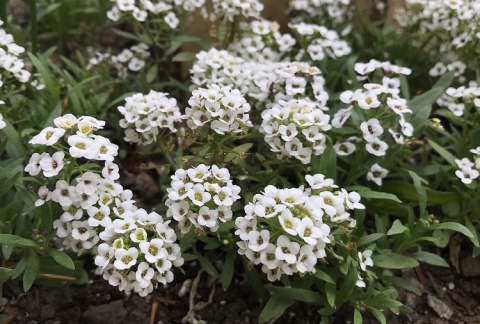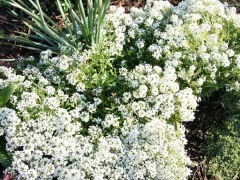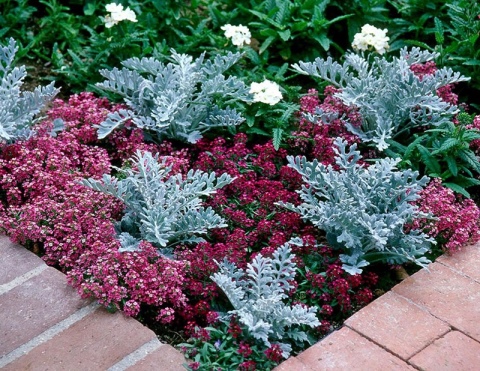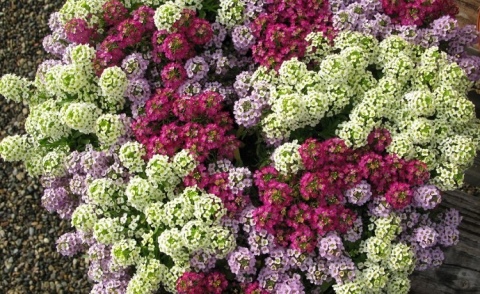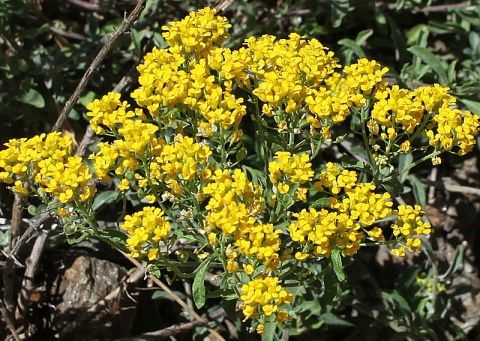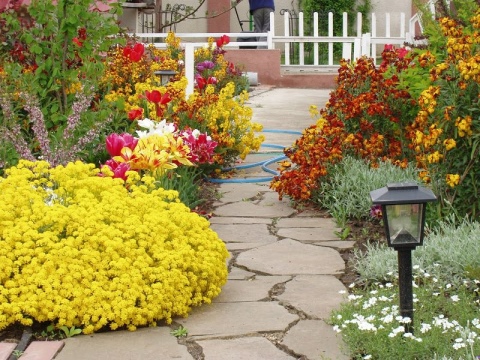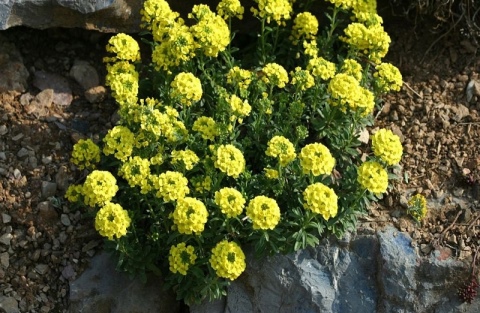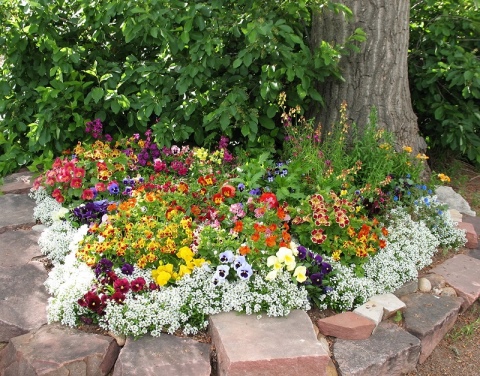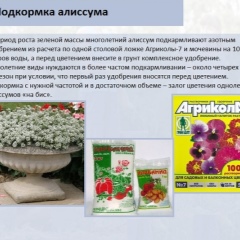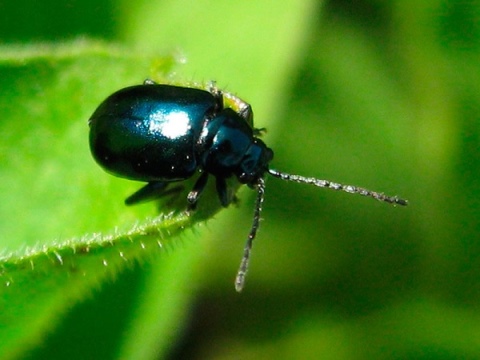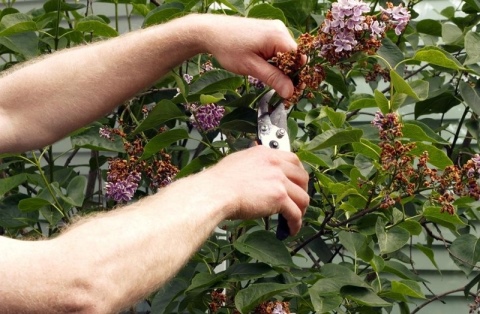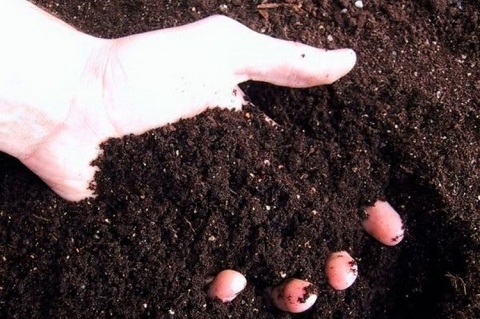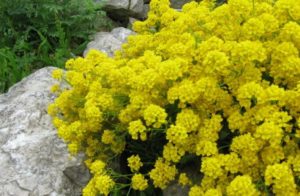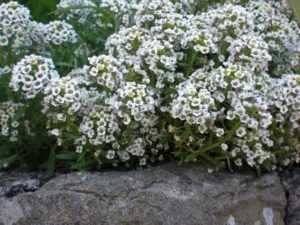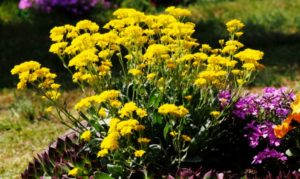Alyssum: growing on the site
It is not difficult to grow sea lobularia. You can sow alissum on seedlings or directly into open ground.
Sowing alyssum for seedlings
Growing through seedlings will accelerate the onset of flowering. If you want to get a beautiful flower carpet in early summer, sow seeds for seedlings in late March - early April. The soil should be light and loose so that moisture does not stagnate in it. You can use a neutral universal soil, or you can mix regular garden soil with sand.
Sow alyssum seeds not too thickly. They need light to germinate, so in no case do not sprinkle them with earth, but just press a little with your palm. Then spill the earth well, cover with foil or glass, and place the containers in a well-lit, warm place.
A few days after the emergence of seedlings (under optimal conditions, they appear on the 4th-5th day), the film can be removed. Further care of the seedlings consists in moderate watering and, if necessary, additional lighting with special lamps.
When the first true leaf appears on the seedlings, feed them with a solution of any complex mineral fertilizer (according to the instructions). After the appearance of the third true leaf, cut the seedlings into separate containers.
In the second half of May or early June, when the threat of night frosts has passed, you can plant seedlings in the ground. Dig holes at a distance of 15-20 cm from each other and make them slightly larger than an earthen ball of seedlings. Water liberally after planting.
Alyssum marine blooms in 40-50 days after germination.
We sow alyssum in open ground
Lobularia can be sown in the ground in April (in a greenhouse) or in May - early June. Choose an open area that is well lit or slightly darkened. 15-20 days before, apply a complex fertilizer to the soil (according to the instructions). Submerge the seeds 1.5 cm in the ground. When seedlings appear, thin them out, leaving a distance of at least 10 cm between them. Otherwise, the plants will develop poorly and may get powdery mildew.
Some growers sow alyssum before winter (in November). In this case, the seeds undergo natural stratification and give healthier and stronger shoots.
With such a sowing, it is important to cover the bed with a non-woven material so that the seedlings do not die during frosts.
Sowing dates
The time when to plant alyssum when grown from seeds is selected taking into account the following factors:
- seed germination is observed within a week after sowing;
- it takes about two months before the first flowers appear from the moment of germination;
- a favorable temperature for the development of a plant and the formation of numerous flower buds is considered to be a temperature of at least 15-18 ° C, but mature specimens can withstand even slight frosts.
Taking into account the climate of the regions
- In the harsh conditions of the northern climate, it makes sense to plant only in seedlings with sowing in early March. In Siberia, seeds are sown in the ground in early May. In this case, alyssum will bloom in July. To ensure early flowering, flowering seedlings are planted in open ground; in this case, it is recommended to sow seeds in March.
- In the regions of the middle lane, sowing seeds is recommended directly in open ground, as soon as the threat of severe prolonged frosts disappears. The seedling method is used here if you want to form a flower bed with specific flowering times for each plant that makes up it.
- In an area with a warm climate, an abundantly flowering plant develops throughout the year and even for several years.It is planted at the onset of stable heat, around the end of April.
Taking into account the lunar calendar
The lunar calendar gives recommendations based on long-term observations of such indicators:
- phases of the moon (days when the moon is in the first and second quarters of the lunar cycle, that is, between the new moon and the full moon are favorable for the development of the aboveground part of plants);
- the position of the moon relative to the earth, that is, through which of the zodiacal constellations the moon passes at the current moment.
|
Month |
Days favorable for sowing and planting flowers |
Days unfavorable for planting flowers |
|
March |
10–16, 19, 20, 23, 24 |
5, 6, 7, 21 |
|
April |
7, 8, 11, 12, 16, 17, 18, 20, 21, 29, 30 |
4, 5, 6, 19 |
|
May |
1, 7, 8, 9, 10, 13, 14, 15, 16, 17, 18, 26, 27, 28 |
4, 5, 6, 19 |
|
June |
5, 6, 9, 10, 11, 12, 13, 14, 15 |
2, 3, 4, 17 |
Growing from seeds
Alyssum is grown from seeds in a seedling and non-seedling way.
Sowing step by step instructions
Seeds for seedlings are sown in March or April.
- Nutritious light soil with a small amount of lime is spread in the boxes. The acidity should be in the range of pH 5.5-6.2.
- Seeds are distributed evenly, not thickly, they are slightly pressed into the ground or sprinkled with a thin layer of substrate.
The containers are covered with foil and left in a well-lit place at an air temperature of 10-15 degrees Celsius.
- Crops are slightly moistened and ventilated regularly.
- With proper agricultural technology, seedlings will appear in 5-7 days.
- After the appearance of the first leaf plate, complex fertilizers must be applied (1 tablespoon per 10 liters of urea or Agricola water).
- Seedlings are dived into separate cups when 2-3 true leaves appear. If the seedlings grow too quickly, they do not need to be planted, but immediately transferred to the open ground.
Landing time in open ground
Alyssum seedlings are planted in open ground in late May - early June. The main thing is to avoid the risks of recurrent frosts.
The site is chosen well-lit with dry, well-drained soil of neutral acidity with a sufficient amount of humus. You can also use slightly acidic or slightly alkaline soil for planting. The plant grows well among stones and slabs that are heated in the sun.
Landing features
Alyssium grows fairly quickly in width. Therefore, an interval of 40-50 cm is left between the bushes when planting.
The planted plants must be watered abundantly. With a strong growth of plants during transplantation into open ground, they can be divided and planted as independent bushes.
Watch the video! Alyssum - from sowing to flowering in one video!
Step-by-step instructions for planting seeds in open ground
If desired, the seeds can be sown directly into the open ground. However, this can only be done in regions with a warm climate.
You can sow seeds in a permanent place or on a growing bed under a film, and then transplant to the desired location. These procedures are carried out from May 1 to May 15.
Step-by-step instructions for planting seeds in open ground:
- The soil is dug up, weeds and their remains are removed, and loosened.
- The dry land is watered, but at this time there is still enough moisture in the soil.
- Seeds are sown over the surface and sprinkled with a thin layer of earth. Seed consumption should be higher than with the seedling method, since germination will be slightly worse.
- The planting site is covered with foil or lutrasil until the seeds germinate.
- With the emergence of seedlings, weeds must be regularly removed, which can drown out young seedlings.
- When planting directly to a permanent place, the seedlings must be rowed according to the 20x20 cm scheme.
The main advantage of sowing in open ground is the lack of an adaptation period.
Landing before winter
This method is used for the cultivation of perennial species, since the seeds will undergo natural stratification and their germination will increase.
Seed sowing rules for the winter:
- Prepare a planting site before frost. Furrows are made in the ground 1-2 cm deep.
- The seeds are sown in November, when the outside temperature is consistently low.
- The seeds must be dry.Dry sand is poured at the bottom of the groove, seeds are sown and sprinkled with soil.
- The next year, after thawing of the soil, seedlings will appear.
- If they appeared early, then they must be covered with a film or lutrasil, stretching over arcs.
- Seedlings are planted in the main place when they grow up.
Seedlings with this method will be resistant to adverse weather. The bushes will be more compact.
What is the difference from Lobularia?
Alyssum may have another name - beetroot. But the names of the lawn or lobularia, which can also often be heard in a conversation with a novice summer resident, are erroneous. Lobularia is considered a close relative of the Burachok genus, but these two words are not synonyms.
Both cultures are united into one family and originally belonged to the same genus, however, over time, botanists identified a difference in the description, structure and developmental specifics of the two plants, and classified them into two genera. Therefore, the equal sign between alyssum and lobularia, often indicated on the seed package, is botanically incorrect. However, the rules for growing these two crops are quite similar.
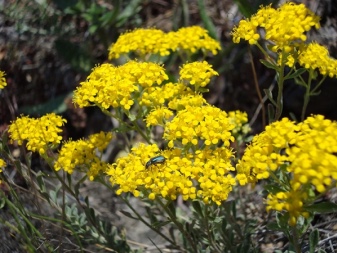

Popular varieties
The first to enter the culture and gave birth to new varieties of sea or seaside lobularia. A low plant (12–15 cm) has a creeping rhizome, when it grows, it forms a pillow, densely covering the soil. Collected in a brush, purple flowers exude a delicate sweetish aroma. Begins to bloom 1.5 months after germination, when grown through seedlings - already in May, withstands autumn frosts.
Royal carpet
Lobularia of this variety creates a truly royal carpet of flowers of all shades of white, lilac, crimson, violet. Dwarf creeping plant 8–12 cm high, popular as a curb and ground cover mixture. Suitable for winter sowing of seeds. Continuous flowering from June to October, refreshing appearance, instant replacement of faded inflorescences with new ones, combination with many garden plants are the advantages of the variety.
Royal carpet is good in the garden
Snow carpet
Lobularia of the Snow Carpet variety is no less charming. The boiling whiteness of fluffy inflorescences really resembles snow, creates a feeling of purity and airiness. Compact bushes 10-15 cm in height grow up to 40 cm in diameter. The culture is sensitive to thickening - when planting, an interval of at least 20 cm between plants should be maintained. White, constantly blooming balls look original in mobile containers, flowerpots, on raised flower beds.
Snow-white blooming cloud
In the very name of the variety - the anticipation of something unusual. Lobularia Oriental nights will not disappoint your expectations - juicy dark purple, purple flowers of the correct shape, with a recognizable honey scent are impressive. Low bushes (up to 15 cm) branch strongly, grow back intensively after pruning. Refreshes the alpine slide, decorates, shades any flower garden.
Pictured Eastern nights
Star pearl
The second name of the variety is the Purple Queen. Lobularia Star Pearl resembles Oriental nights. Miniature highly branching bushes are distinguished by the density of flowering, the intensity of the growth of new shoots and peduncles. Quickly fills the free space of the flower bed, creating volume. An unpretentious, cold-resistant culture can be grown through seedlings and under-winter sowing. The variety is prone to abundant self-seeding.
Alyssum species and popular varieties
Popular types of alyssum can be found in specialized flower shops. It is better not to grow rare flower varieties, they do not have zoning and require increased care to obtain mediocre flowering.
Suitable for growing in the climatic conditions of Siberia, the Urals and the Volga region - rock alyssum (alyssum saxatile). Refers to perennial crops. It tolerates a short-term drop in temperature on the soil and in the air to minus 10 °. During the growing season, it grows up to 35 cm in height.Spreading bush, for successful growth requires space up to 50 cm in diameter. It blooms exclusively with yellow tassels.
Its common varieties:
- "Compactum" - a low, up to 15 cm bush, suitable as a border plant;
- "Plenum" has double flowers "
- "Golden Wave" will bloom only in the second year after planting.
The marine species of alyssum belongs to the lobularia and is distinguished by a variety of shades of buds. A perennial plant that retains its decorative effect even during the snow cover. The leaves of a rich green color remain on the bushes until they are almost completely covered with snow. Frost-resistant, it winters well in open ground, even in regions with temperatures below minus 30 °. It is a creeping species, suitable for ground carpets. The maximum length of the branches is 45 cm. It is also used as an ampelous culture. Natural shades of buds are snow-white and lilac. Lush blooms of red, blue, purple and pink are harder to achieve.
The varieties of sea alyssum available for growing from seeds:
- "Esther Bonnet Deep Rose" (Easter Bonnet Deep Rose);
- Princess in Purple;
- "Violet Konigin" with purple bloom;
- Tiny Tim blooms with white buds.
Mountain alissum is also called Gmelin's beetroot (alyssum montnum). It is an evergreen plant used for landscape compositions in different regions of the country. Feels great among the pile of stones, tolerates frosts down to minus 40 °.
Varieties of mountain beetroot with increased decorativeness:
- "Palette" with a wide variety of shades (violet, lilac, pink, snow-white, crimson, orange);
- "Gold placer" forms a spherical bush with numerous yellow flowers without additional pruning;
- "Big Jam" differs in that it continues to bloom even at minus 5 °;
- "Pink rug" - ampelous variety with pink buds of a rich shade and long lashes (up to 60 cm);
- "White carpet" is resistant to trampling and can be used as a lawn crop.
Alyssum creeping (alyssum repens) became the ancestor of another species - ampelous. It grows wild in Central and Southeast Asia, the Mediterranean part of Europe. Perennial crop, tolerates frost and drought well. Differs in a gray-green color of leaves and an impressive length of shoots (up to 80 cm). Blossoming in yellow shades from early spring to the establishment of snow cover in late autumn.
Other interesting varieties of alyssum:
- "Snow carpet" - allows you to cover a large area of soil with dense greenery with white brushes of flowers within 2-3 weeks;
- "Pink Queen" has a dwarf growth and a strong aroma when lilac buds bloom;
- "Gita" is distinguished by its rapid growth and vegetative development, when cuttings it blooms again at home;
- "Easter hat" has a wide variety of shades, blooms from early April to late October;
- "Aphrodite" is suitable for landscaping loggias, balconies and terraces.
New hybrids and varieties are constantly appearing - when buying seeds, pay attention to whether they are suitable for growing in your region of residence
Growing at home
To get a thick carpet or a beautiful floral border, you need to plant more than a dozen plants. Considering the prices for ready-made seedlings, it is more profitable for the lobularia to grow from seeds at home. An unpretentious annual plant perfectly tolerates podzimny sowing, it can be sown in spring with seeds in open ground, or you can try to grow seedlings.
Growing seedlings
Experienced growers prefer the seedling method, although this is more troublesome. What are the advantages?
- Early flowering is not at the end of June, but already in May.
- Freezing from spring frosts is excluded.
- The flower garden is planted evenly, there are no bald spots if the seeds have not sprouted.
Sowing technology is no different from other annuals.
Sowing seeds
Lobularia seeds are small, remain viable for 3 years. In room conditions, they sprout, depending on the variety, after 10-15 days.
Prepare a container with soil in advance. The container should have drainage holes. Plastic containers with a lid are suitable - this is a ready-made mini-caddy with a good volume of air. The soil needs light, breathable. It is good when the composition contains high moor peat, river sand - they have loosening properties.
Before sowing lobularia on seedlings, the soil is moistened, if necessary, disinfected by spilling a solution of manganese or antifungal drugs. Grooves are drawn on the surface, in fact, they outline the direction of the rows. Flower seeds are very small, they are sown on the soil surface. The maximum can be sprinkled with a layer of coarse sand no more than 0.5 mm. After sowing, the seeds are lightly pressed with a wooden block, the soil surface is sprayed with a spray bottle.
Advice! Sowing of small-seeded annuals in the snow is effective. It is placed in a layer on top of the prepared soil, the seeds are evenly distributed. Gradually melting, the snow will draw in the seeds to the desired depth. Short-term cooling stimulates the awakening of the embryo, faster germination.
The container with the sown seeds is covered with a transparent lid or placed in a plastic bag. In this form, they are until germination, which will appear approximately in 2 weeks. Every day, the greenhouse needs to be ventilated, if necessary - moistened
But you need to be careful with water - although alyssum is sea, it does not tolerate being locked
Sowing time
The answer to the question of when to plant lobularia for seedlings depends on how early spring comes in your region. The optimal time for the middle lane is the first half of March. By this time, daylight hours increase and the seedlings are strong, do not stretch, they take root better.
Seedling care, planting
Thin, fragile seedlings emerge from small seeds. If a lot has sprung up, they are thinned out, leaving 2-3 pieces at a distance of 10 cm. The second option is to dive into cups or pots. It is also recommended to take several plants in case something does not take root.
So that the lobularia does not freeze, seedlings are planted after May 10. Flowers are planted in a sunny area in groups, observing an interval of 20 cm.
Direct sowing in the ground
Lobularia can be grown from seeds by spring sowing in open ground approximately from mid-April. The site is well loosened, leveled, complex mineral fertilizers are applied before sowing. Sow on the soil surface. The technology is the same as for growing seedlings.
Advice! The annual reproduces by self-sowing, keeping varietal characteristics. Seedlings emerge early, develop rapidly, catching up and overtaking seedlings. Seedlings are thinned out, some of them can be planted for further cultivation.



